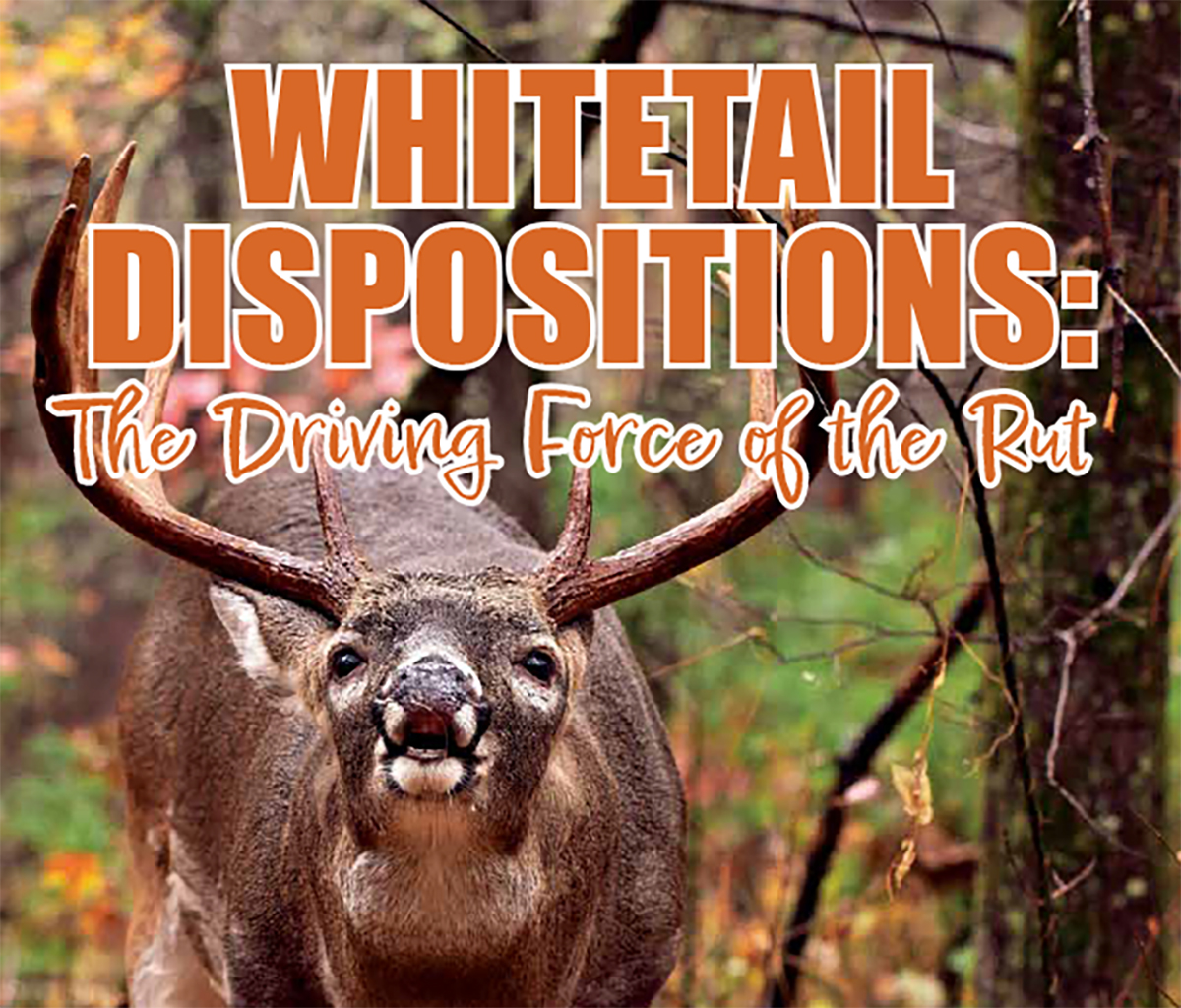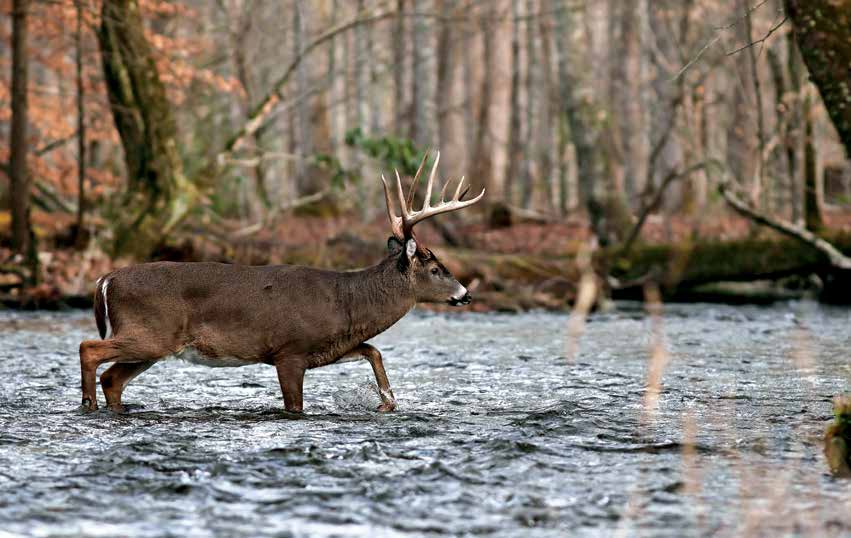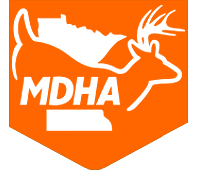
- Tommy Kirkland
- From Whitetales
- Hits: 3517
Whitetail Dispositions The Driving Force of the Rut
- Tommy Kirkland
- From Whitetales
- Hits: 3517
For decades, hunters and biologists have speculated and analyzed what really instigates and dictates the whitetails’ rut. Is it really the moon phase, or a combination of environmental and biological factors? Is the rut simply blueprinted by estrous females and their genetics; and what about those individual bucks that seem to be ahead of the ball game – dominating the whole playing field – even before does are receptive? Beside testosterone, a buck’s personal attitude also has a strong influence on its ability to successfully rut…..
Deer activity is booming. Although the historical timing of the peak rut is still a few weeks out, mature bucks are beginning to scent mark the timber. Everything appears to be right on track, just like years before.
Observations are showing however, that one particular mature 10 pointer to the east of the fields is in high gear – more so than other bucks. He is continuously battering the trees and scenting for doe urine. Undoubtedly, as compared to previous years of signposting activity, this particular buck is out of the norm. In fact, no other mature bucks in the vicinity are exhibiting this degree of pre-rut rut behavior.
The mature 10 pointer is harassing the females – prematurely chasing small herds here and there. Yet, the height of the actual rut where females are fully receptive to breed is still a month away in comparison to years past.
So why is this buck ahead of the ball game? Other mature bucks – not only in his home range, but up to a mile and half away are slower in displaying rut behaviors. What is driving him to such an extreme when the rut is still pending?
Genetics, Testosterone, Nutrition, & Rival Attitudes
Typically as the days shorten, there are hormonal changes in a buck’s metabolism. In turn, as autumn unfolds and the nights get cooler, testosterone also increases during this time – instinctively triggering more activity for males to prep it up for the upcoming mating season.
Once a buck reaches his peak, his testosterone is undoubtedly a major calling card for breeding. There are cases where some bucks display evaluated levels of this hormone more so than other mature bucks. This can be seen in the degree of swelling with their throat, chest, and neck areas as well as behaviors.

It cannot be denied that even yearling and
young bucks with lower levels of testosterone
display gritty attitudes when attempting
to get in on the rutting action. This clearly
shows that higher levels of testosterone do
not solely dictate rutting behaviors.
Biologically speaking, testosterone increases more and more as female deer near breeding receptivity. Here female scent stimulates a buck’s testosterone. All these physical changes are primarily driven by the degree of whitetail communication where both bucks and does scent mark the trees. This is one, if not the main stimulant for getting the action going.
Though it always doesn’t hold true, usually the buck exhibiting high levels of testosterone is the most aggressive and dominant buck for that specific locale. Yet, why would a particular buck increase high levels of testosterone before other bucks and prematurely in comparison to the normal times for pre-rut/rut behaviors?
Although the scientific data is correct here as to testosterone’s biological function instigating the rut, there are other factors that excite a buck’s intense rutting behavior.
Here again, from a biological perspective, superior genetics dictating testosterone could very well play into a buck having the grit to rut more so than other mature bucks.

The instinct of fight or flight influences the rut more so than typically believed. Of course, whitetails do not possess personalities with mental reason in comparison to humans. To do so would be the humanization (anthropomorphism) of wildlife, and that is the perspective of extreme anti-hunters. With that said, deer undoubtedly respond based on the instinct of “fight” or “flight” as well learned experiences with either negative or positive reinforcement.

If a particular buck possesses solid genetics which enhances his testosterone levels, has maintained good nutrition, and leans
toward this dominant fight disposition (dispositional instinctive competitiveness), then these forces work together - creating a
brawling, dominant breeding machine.
Of course, quality nutrition is another important factor in dictating a buck’s rutting stamina. Yet besides high levels of testosterone and nutrition influencing a buck’s rutting behavior is also his individual disposition.
The instinct of fight or flight influences the rut more so than typically believed. Of course, whitetails do not possess personalities with mental reason in comparison to humans. To do so would be the humanization (anthropomorphism) of wildlife; and that is the perspective of extreme anti-hunters. With that said, deer undoubtedly respond based on the instinct of “fight” or “flight” as well learned experiences with either negative or positive reinforcement.
For example, if the instinct of flight is a predominant trait with a buck, then that particular deer is going to be extremely alert. He will be sensitive and evasive to sound, scent, and movement. If he has been bullied and pounded to the ground in previous rut battles, he will surely retain the experiences and usually avoid confrontation. This reluctance also influences as to what degree the buck will scent mark and respond to female scent communication. If the buck or bucks that gave him beating before are in the vicinity, then the flight instinct to avoid confrontations will typically be reinforced.
On the other side of this instinctive pendulum is the fight attitude of a whitetail. Here a buck tends to be more assertive. He could also be dominating other bucks – regardless of antler size. All in all, the fight instinct, prevalent all year, heightens as breeding nears.
These dispositional traits can dictate the rutting buck. Personally, I refer to this as dispositional instinctive competitiveness. Here again, to avoid humanizing animals, this type of rival behavior is not to be compared to human ambition and competition with conscious reasoning. Traditionally, deer biology terms that testosterone is the driving force to instinctive rut behaviors. Although this is undoubtedly true; numerous observations are now putting these dispositions of “fight or flight” into the complexities of whitetail breeding.
It cannot be denied that even yearling and young bucks with lower levels of testosterone display gritty attitudes when attempting to get in on the rutting action. This clearly shows that higher levels of testosterone do not solely dictate rutting behaviors.
Finally, if a particular buck possesses solid genetics which enhances his testosterone levels, has maintained good nutrition, and leans toward this dominant fight disposition (dispositional instinctive competitiveness); then these forces work together - creating a brawling, dominant breeding machine….
Article and Photos by Tommy Kirkland





